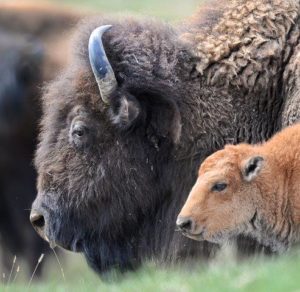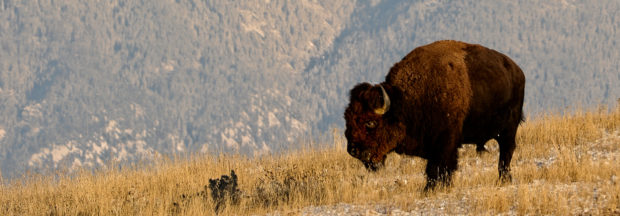We have much more to do and your continued support is needed now more than ever.
Wild Bison on Montana’s Horizon
Why would anybody oppose restoring at least some of the West’s most iconic animals to the wild?

But the time when wild bison again roam the Montana prairie is fast approaching. That’s the inescapable conclusion of a thorough environmental-impact study from Montana’s Department of Fish, Wildlife and Parks.
The agency’s analysis of various bison-restoration scenarios clearly shows that wild bison can be successfully managed in some large areas of native habitat in Montana with many benefits and few potential negative impacts, all of which can be mitigated.
Prime Prairie Habitat
National Wildlife Federation has for years advocated the return of wild bison to a vast area of public land in north-central Montana. America has a lot of bison, but most of them exist as privately owned livestock fenced in and managed virtually the same as cattle. Some modest herds of bison endure in some national parks and wildlife refuges. A few small herds of wild bison have been restored to Utah, Arizona, Alaska and a couple of Canadian provinces – more or less in fringes of their historic range.
NWF is committed to restoring a significant herd of wild bison in the epicenter of the species’ historic range in the Northern Great Plains – the area in and around the million-acre Charles M. Russell National Wildlife Refuge. Best known by its initials – CMR – the refuge is a largely intact piece of prairie – prime, historic bison habitat little changed from the days of pre-settlement, land just waiting for the animals’ return. The CMR was created for the explicit purpose of restoring and conserving native wildlife. We don’t know a better place in all of North America for bison to roam free.
Broad Support, Powerful Opposition
The state’s bison analysis is a big step forward. Although polls show 80 percent of Montanans have favorable views of bison and more than 70 percent favor having the state restore bison to an expanse of public land like the CMR, Montana wildlife managers have approached the issue timidly. That’s because – despite the overwhelming public support – Montana’s politically powerful cattle industry opposes returning bison as wildlife.

The new study also addresses competition for grass between bison and cattle. The two species coexist well in places like Utah’s Henry Mountains and the Sturgeon River area of Saskatchewan. One study in Utah found jackrabbits eat more grass and thus compete more with cattle for forage than do bison.
Montana’s study offers reassuring examples of bison restoration in other states and provinces, and all of the factual and analytical information shows that bison restoration can work well in a large landscape such as the CMR.
If there’s a disappointment in the bison environmental impact statement, it’s that state wildlife officials stopped short of evaluating any particular site or proposal for restoring bison – despite the fact that CMR has been the focal point for years. Another round of site-specific environmental analysis will be needed before we see wild bison in and around the CMR.
So the “where,” “how” and “when” remain to be decided. But the Montana study seems to leave no question about whether restoring bison to native prairie habitat is feasible and desirable.
Unfortunately, no amount of factual information is likely to persuade opponents in the ranching industry – at least not in the short run. And because agricultural interests have such a strong voice in Montana, it’s vitally important that state officials hear from people who value wildlife and want to see at least some wild bison roam free on public lands in the Northern Plains.
Offer an Encouraging Word
The best bison habitat is in Montana, but these animals are a national resource, and the lands in question are federally managed public lands owned by everyone. Bison restoration in Montana is an opportunity for all Americans, and the more people voicing support at this critical stage, the better.
![]() You can weigh in with an encouraging word about bison by commenting on the environmental impact study by Sept. 11. Let Montana wildlife managers know you think the new study supports bison restoration, and encourage them to move ahead with a site-specific analysis of restoring bison to the CMR.
You can weigh in with an encouraging word about bison by commenting on the environmental impact study by Sept. 11. Let Montana wildlife managers know you think the new study supports bison restoration, and encourage them to move ahead with a site-specific analysis of restoring bison to the CMR.





















